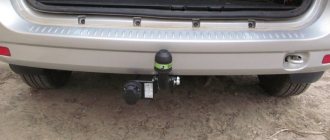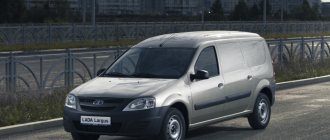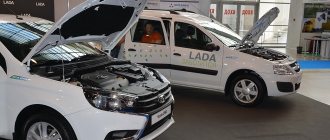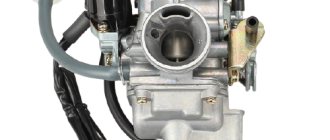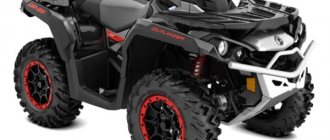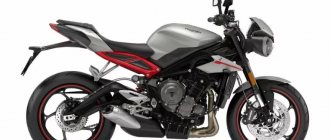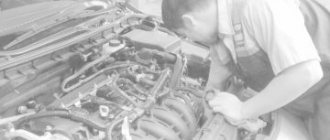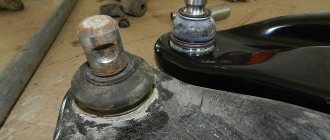After the obvious success of the B 0 platform and all its derivative models from Lada to Nissan, the issue of bringing the full model range of the Romanian Dacia depended solely on the situation on the domestic market. Although the French remained completely silent on this matter, the very first increase in sales - and the regiment arrived: the Dokker . Unfortunately, they did not localize the car, and therefore the price turned out to be higher than expected. Let's see if it makes sense to pay extra or save money and opt for the related Lada Largus ?
Practical station wagons with increased capacity have always been in limited but steady demand in Russia. Partner, Berlingo, Kangoo, Caddy were bought by summer residents, travelers, and small businessmen, and Fiat Doblo at one time made the Italian brand a cash register in Russia. But with the onset of the crisis and the collapse of the ruble exchange rate, the cars doubled in price, losing their attractiveness, and the Kangoo and the simple Doblo of the previous generation disappeared from the market. As a result, the choice turned out to be polar: either the budget Largus, or the sophisticated and expensive “French” with “Germans” and “Italians”.
In absentia, Renault Dokker found itself in the right niche. The starting price of 869,000 rubles positions the “heel” exactly in the middle of the price offer. But, alas, it will be an almost empty car, suitable only for a corporate fleet. A package of options necessary for comfort, an elegant color and beautiful wheels - that’s what turned out to be a million rubles. Lada is three hundred thousand cheaper, Parnter and Berlingo are three hundred thousand more expensive. Even when buying on credit, the difference will be noticeable. Is it noticeable on cars?
The appearance of the Renault Dokker is far from designer delights, but it is not devoid of style and embellishment. The most striking element is the radiator grille with a chrome honeycomb mesh. Although the machine still looks utilitarian in its dim silver color, you cannot deny its visual neatness and neatness. In general, to make Docker look elegant, it’s definitely worth playing with the color palette.
The appearance of the Largus, or rather the first generation Logan MCV, is already twelve years old, for which, of course, we have to make allowances. Russia has long been accustomed to the angular image of the first Logan, and besides, for testing we got a purely domestic version of the Cross, which is an off-road modification of the station wagon. Despite its age, the car doesn’t look completely outdated; the rugged design even reveals a nostalgic comfort, and the powerful body kit is downright attractive. By the way, Europeans also liked the performance - the second generation of the Logan MCV station wagon also acquired an off-road version of Stepway.
But landing inside the Largus takes you back to the beginning of the 2000s. No, it’s not at all a matter of budget materials and simple decoration on the verge of asceticism. This is not at all annoying and fits completely into the class and cost format. Ergonomics! Loganov's ergonomics, which everyone trampled on at one time. Scoliosis seats with a dip in the lumbar region, a horn on the steering column switch, power windows on the center console, adjustable mirrors under the handbrake, small wipers that leave half the glass on the right uncleaned. Add to this the small ranges of adjustment for the steering wheel and seats - and you get a car in which driving comfort is a nominal concept, which is compensated by the combination of cost and incredible functionality of the car as a whole.
Renault Dokker, of course, is a car from a different generation. Actually, the second, in which the French took into account almost all the claims that fell upon the first Logan. Firstly, the high body itself favors a more comfortable fit. Of course, the amount of headroom noticeably adds spaciousness. Plastics are also hard everywhere, but their texture with a touch of design is much more pleasing to the eye. We are pleased with the comfortable molded steering wheel and, of course, noticeably more comfortable seats with designated lateral support. Well, the ergonomics here are on a completely different level - everything has moved into place.
Even in the most expensive Docker configuration, you need to pay extra for the radio - at least 12,990 rubles. And for 20,990 rubles a multimedia complex with navigation will be available. In addition, Renault has a stabilization system and cruise control. The Lada Largus has a simple but good-sounding “music” as standard, starting with the middle trim levels. You can't get the rest even for money
Three people can enter the passenger compartment of the Dokker - thanks to the same roof height, convenient sliding doors and a wide molded sofa. There is plenty of space, but minimal amenities. And the savings also had an impact - half of the skin in the Renault is missing, which is why the car is perceived as a kind of charabanc. Lada does not have such a problem.
Getting into the Largus is pleasant thanks to the wide doors and knee room. The sofa is soft, does not have the most sloping back, and besides, it is set high, which makes the seating position in the second row specific and not everyone will like it. Well, the Lada’s main trump card is a full-fledged third row of seats, which can accommodate two more passengers absolutely comfortably. The gallery has handles, armrests, cup holders and even windows that open slightly.
There is a shelf above your head in both cars. Only in Renault (left) it is in the usual place for the front passengers, and in Largus it is unexpectedly made for the rear. Considering the height of the ceiling of the Lada, without wearing seat belts, passengers can fly into it head-on during sudden braking.
What's the result?
It’s no secret, the Renault Dokker is, of course, a car of a completely different level and perception. It is more modern, more convenient, better equipped and more functional. Plus it is noticeably cheaper than any direct competitor. We definitely recommend paying attention to Docker when choosing any of them. But we can’t definitely recommend paying extra for the “French” when comparing with “Largus”, and there are two reasons for this.
Firstly, the Docker has some disadvantages: a simple interior, issues with ride comfort and unbalanced configurations. All these are consequences primarily of a commercial rather than passenger nature.
And secondly, Lada Largus turned out to be not so much simpler as it was cheaper. In fact, all complaints about the domestic station wagon come down solely to poor ergonomics and landing, which Largus inherited from the first Logan. Otherwise, this is a simple (in some places too much), but very functional car, which for the advertised money simply has no competitors, as sales show. Largus is absolutely naturally included in the top ten most popular cars in Russia.
The editors of the “Engine” magazine express gratitude to the official Lada dealer in St. Petersburg, and the Russian representative office of Renault for the cars provided.
Despite the fact that the manufacturer positions the Lada Largus as a completely new and independent model, at its core it represents a slightly modified Renault Logan MCV station wagon, which was popular in many countries around the world, including Russia. Whether such borrowing is bad or good is up to everyone to decide for themselves - some will not like copying other people’s ideas, even if officially permitted, while others will rejoice at the use of time-tested technologies. Considering that the Renault station wagon can still be bought in Russia, it will be interesting to know which is better - Logan or Largus? It is worth remembering that the car produced by VAZ underwent modifications before being put on the production line - many motorists want to find out what it was.
And again we compare the Lada Largus
Making a choice
If you are a family man and you have two or three children, then you will be nowhere without the Lada Largus! There are enough places for everyone!
Provided that you are a lover of summer cottages , and when returning home, bring huge bags or homemade products, then a gigantic and convenient trunk will help you!
In case you love to travel , then this option is also suitable for you. In particular, it is better to do this on Largus Cross, which copes well even with destroyed roads.
To work as a driver, Logan is suitable for you, since the dynamics are better and the consumption will be less.
What are the differences?
The difference between the cars is that the Lada Largus was initially adapted for use in the harsh Russian climate. First of all, this concerns corrosion resistance - Russian specialists have selected an original composition for anti-corrosion treatment, which much better withstands the effects of low temperatures and aggressive chemicals that are used to treat roads in winter. In addition, all configurations of the Lada Largus received reinforced linings in the wheel arches, while the basic versions of the Renault Logan are not equipped with such devices at all. The rear protection pads have been redesigned to cover areas most sensitive to stone impacts. Compared to the Renault Logan, the Lada Largus has increased the surface area covered with sound insulation and anti-gravel mastic.
Interior
The French station wagon wins in terms of interior appearance: richer equipment, better quality materials, as well as a multimedia system with a large monitor. The highlight of the Renault Logan MCV is the basic offer, which can be installed for an additional fee:
- side airbags;
- alloy wheels;
- multimedia navigation system.
It should be noted that there is good visibility from the inside, thanks to the voluminous side mirrors. Regarding the dimensions of the luggage compartment, the Frenchman is also in the lead here: 573 liters versus 560 liters for the Russian. In turn, the Lada Largus boasts a more comfortable interior, as well as more space in the rear seats, which will significantly affect the comfort of passengers, especially on long trips. The Lada package also includes alloy wheels, ABS, front airbag and climate control for an extra charge.
On the run
Since the technical base of the car remained unchanged when production was transferred to Russia, it is simply pointless to compare the main characteristics. However, at the level of subjective sensations, the Lada Largus turns out to be a little faster than the Logan MCV with a similar gasoline engine. The point is not in increasing power, but in a different setting of the gas pedal, which has become more sensitive to weak touches - thanks to this, it was possible to significantly improve the engine’s response to the driver’s commands. Driving the station wagon in a traffic jam has become much easier - the brake pedal has received a slight free play and gradually increasing force, unlike the Logan, in which a sharp deceleration occurs after a light touch.
The gearbox has remained almost unchanged, but the shift drive has undergone significant modifications, as a result of which the lever strokes have been reduced. The convenience of driving in the city has increased, but at the same time the likelihood of errors when choosing the required gear has increased. If we compare the Lada Largus or Renault Logan in terms of driving comfort at low speeds, then the first car definitely looks better in this comparison. The first gear in the Russian station wagon is made longer, which allows you not only to start, but also to move slowly without the strained roar of the engine.
According to the manufacturer's specialists, the steering has also been retuned, although significant differences in most driving modes are not noticeable. Only when driving on very bad roads does the Lada Largus hold the chosen straight trajectory a little better, without causing the driver to flinch from strong vibrations. The suspension became a little stiffer, which reduced comfort, but at the same time it allowed us to achieve a number of advantages:
- Increase energy intensity, and, accordingly, reliability when driving frequently on bad roads;
- Increase stability in sharp turns;
- Reduce wear on the undercarriage when driving at full load.
If we talk about the Largus Cross version, which is distinguished by increased ground clearance, then it represents the ideal Renault Logan that its owners have been trying to get through tuning for many years. Increasing the ground clearance had a positive effect on cross-country ability, as well as protecting the bottom from accidental impacts. At the same time, the car did not handle worse and did not lose stability at high speeds, and fuel costs increased slightly. Another advantage of Largus Cross is the use of impact-resistant plastic body kit, which can withstand heavy loads and does not require high replacement costs.
When choosing a new Logan or Largus based on the comfort of the driver’s seat, you can again make a choice in favor of a Russian car. This is not due to differences in the controls, which are actually absent, but to improved seat upholstery, which reliably holds a person even in sharp turns. In addition, the optimized shape of the front seat cushion in the Lada Largus allows a person of any size to take a comfortable position on a long journey.
Is Largus a copy of Logan?
Experts note that the Lada Largus is an almost complete clone of the Renault Logan. True, there are some nuances in cars that distinguish them. More on this below.
Exterior
Rear seats (Renault Logan edition)
If you examine Logan from the outside, you may not notice the details in which it differs from Largus. Externally, the cars are almost identical. But inside the cabin, changes are immediately noticeable. All of them are in favor of Lada.
Salon Lada Largus
The driver can sit comfortably behind the wheel in one or another car. The seats can be adjusted in different positions.
The disadvantages of Renault include some small details, for example, the heater control is located too low. (Renault Logan editors)
To adjust, you will need to take your eyes off the road. Also, with the rear row seats folded down, the car becomes too noisy.
Otherwise there are no differences. The handling of the car is the same, the landing too. The build quality is good, as are the ergonomics. The only difference between the cars is the cost.
Service
It should be noted that most Renault owners “get” some little things. For example, the backlighting of the buttons often burns out. When contacting a service station, it turns out that the entire button must be replaced, since the diode cannot be replaced separately.
In winter there are no problems with both cars. They start the first time. Here you just need to monitor the quality of the fuel. The suspension is good; unscheduled replacements of its elements will not be required during normal operation.
Specifications
Both cars can be equipped with a range of engines, which include both diesel and petrol units. They can work in tandem with mechanics or automation. Drive – front. The engine power in both cars is enough for comfortable movement on the highway and in the city. The cost of spare parts will be cheaper for Lada, which is its advantage over Renault.
Results
Which car to choose is up to you. Here you need to take into account your capabilities and the conditions in which you plan to operate the car.
Improved version
Russian engineers were able to complete the task with honor - they retained all the advantages that Renault Logan was famous for and even added new advantages. The car has become adapted for use in difficult climates, as evidenced by improved underbody protection, as well as the presence of a rear windshield wiper and an enlarged washer reservoir in any configuration. On the road the car is a little less comfortable due to the stiff suspension, but it is very stable and reliable in all situations. Retuned responses to pedal pressure helped make driving in the city as comfortable as possible. We can conclude that the Lada Largus is an ideal Renault Logan, which fully takes into account all the conditions of reality in which it will be used.
Many models are based on the so-called B0 platform, which is widely used by the Renault-Nissan concern and its subordinate manufacturers. In Russia alone there are about a dozen such cars - and there are plenty of differences between them. ZR tested these machines at different times; it’s time to summarize our measurement data in one table and understand the strengths and weaknesses of each model.
Renault > Logan
Renault > Sandero
Nissan > Almera
Renault > Duster
Nissan > Terrano
LADA > XRAY
The most popular
The first-born on the B0 platform was the Dacia Logan sedan, which began production at the Pitesti plant in 2004. This was preceded by the purchase by the Renault group of the Romanian brand Dacia and the development of a new budget platform for emerging markets. The price of the finished car should not exceed 5,000 euros in the basic configuration, and this imposed certain restrictions on the engineers. We settled on the most popular front-wheel drive layout with a transverse power unit. Many ready-made solutions were borrowed from other production models: the McPherson front suspension and the elastic H-shaped rear suspension from Renault Clio, engines and gearboxes from Megan. The main stage of development was computer modeling, which made it possible to reduce time and costs for R&D, and the “transitional” Romanian models Dacia Nova and Solenza acted as “mules”.
Renault Logan
Despite its simplicity (basic configurations do not even have power steering) and simple appearance, Logan was captivating with its spacious interior and trunk compared to its older classmates, indifference to the quality of roads and simplicity of design.
The most compact
The shortest of the lineup, which is based on the B0 platform, was the Renault Sandero hatchback. In Romania - naturally, under the Dacia brand - it was mastered in 2007, Sandero received Moscow registration in 2009. The life cycle of this model turned out to be noticeably shorter - in Russia, production was curtailed at the end of 2014, having managed to produce almost 200 thousand cars.
Renault Sandero
The advantages of the hatchback are the notorious “Logan” reliability and the presence of an elevated version of the Sandero Stepway, which was distinguished not only by increased ground clearance, but also by a body kit made of unpainted plastic around the perimeter of the body. In addition, the hatchback turned out to be almost 300 mm shorter than the sedan, which simplified parking in big cities, and the wheelbase shortened by 42 mm made it possible to reduce the turning circle from 10.6 to 10.5 meters. However, this coin also has a downside: Sandero was and remains the most cramped for rear passengers among the platform-based vehicles, and is also inferior to them in terms of cargo capabilities. However, the 276 liters we intended is quite a worthy result. And the second generation Sandero, which has been produced in Togliatti since 2014, has an even larger trunk - 304 liters!
Nissan Almera
One way or another, this is the most spacious (except for the Largus station wagon) car built on the B0 platform. Thanks to the wheelbase of 2.7 m, the legroom for rear passengers is the most impressive. The trunk, although less spacious than Logan’s, also did not disappoint - it is designed for 400 liters. With such data, Almera claims to be both a dacha mobile transporting seasonal belongings, seedlings and crops, and to serve as a taxi. In the end, the message “A black Nissan has arrived at you” sounds somehow more respectable than “a yellow Renault is waiting for you.”
The most versatile
Lada Largus is another example of badge engineering. The Romanian Dacia Logan MCV debuted back in 2006, but only in 2012 did this high-capacity station wagon reach our market, registering on the AVTOVAZ assembly line, and a boat moored on its radiator grille.
Engines and transmission
Both manufacturers produce their cars with several types of engines for customers to choose from. In the first case, there are both gasoline and diesel engines with the following characteristics:
- gasoline, volume 1.6 liters with a power of 85 horsepower;
- petrol turbocharged with a volume of 1.2 liters and a power of 115 hp;
- 1.5 liter diesel with a capacity of 75 “mares”;
- diesel, volume 1.5 liters, power 90 “horses”.
The Russian car can have the following power units:
- gasoline, volume 1.6 liters, power 87 hp;
- volume 1.6 liters, petrol, developing power up to 106 “horses”;
- volume 1.6 liters, bi-fuel (gas, gasoline) with a capacity of 106 horsepower.
Station wagons do not have impressive speed characteristics. True, Renault in versions with the most powerful power units has a slightly better figure than Lada. But despite this, cars are more designed for calm drivers. At the same time, they are fuel efficient. And the Russian bi-fuel version is a super economical option for those who travel a lot and are not ready to pay a lot of money for gasoline.
Both cars are available for sale only with a manual transmission.
Both the Frenchman and the Lada Largus are exclusively front-wheel drive cars.
Lada Largus Cross
Finally, for commercial transportation there is a van - and for economical ones, AVTOVAZ is developing a version with a bi-fuel engine that can run on both gasoline and methane.
Most passable
The Renault Duster crossover embodied the dreams of those for whom the capabilities of the UAZ Patriot seemed excessive, and the Chevrolet Niva was not satisfied with its low-power engine. The relatively affordable all-terrain vehicle began to be assembled at the Moscow plant in 2011, with a two-year lag behind its Romanian counterpart. At first, all-wheel drive versions (front-wheel drive versions are also available) were offered only with a manual transmission, but then - especially for us! — for the 4x4 versions, the four-speed automatic DP8 was adapted.
